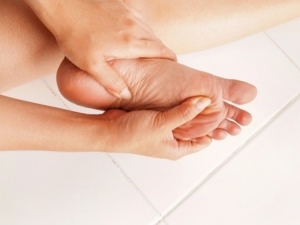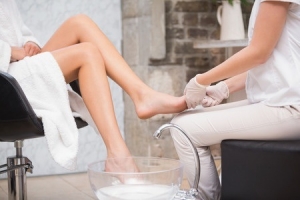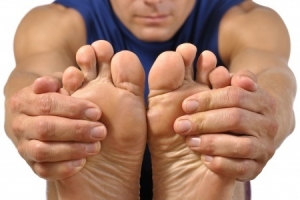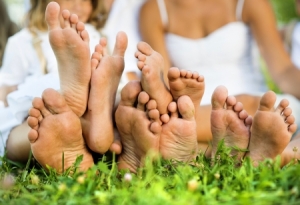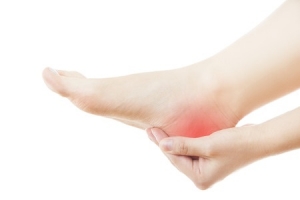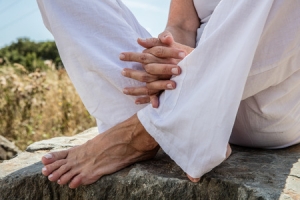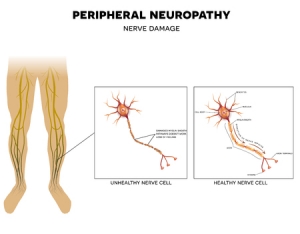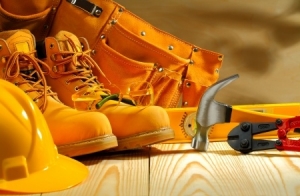Connect With Us
Blogs
Summer Checklist for Preventing Children’s Foot Problems
Chances are with the end of the school year your child came home with readings lists and other summer work. At Superior Foot & Ankle Care Center we’d like to add one more list: a checklist for taking care of your child’s feet over the summer months. Summer brings a whole new set of activities and options for children, many of which can lead to foot trouble if the proper precautions are not taken. Here are our top tips for keeping children’s feet healthy this season:
Slather on the Sunscreen—many people forget to apply sunscreen to their feet. The skin on your feet is just as susceptible to the harmful effects of UVB and UVA rays as that on the rest of your body. On beach and pool days you should put sunscreen on the tops and bottoms of your children’s feet and reapply after swimming. If your children are wearing sandals or other open shoes and will be out in the sun shopping or sightseeing you should also put sunscreen on their feet then.
Pack the Flip Flops—summertime is high season for athlete’s foot, fungal toenails and warts, all of which are spread by direct contact with the virus, fungi or bacteria that cause them. If you are spending time at a community pool or local beach make sure your child keeps their feet covered around the pool and in changing areas and bathrooms—these are prime hangouts for fungal infections. Encourage your children not to share shoes, socks, towels or any items that touch someone else’s feet.
Inspect Shoes—be sure that your child is wearing shoes that match the activity they are participating in. While flip flops are good for the pool, they can lead to injury if used for playing whiffle ball or other casual summer sports. Also keep an eye on fit—children’s feet grow fast and time spent squeezed into shoes that are too tight can increase the risk of ingrown toenails and fungal infections.
Keep it Clean—wash your children’s feet at the end of every day with a mild soap and warm water. Be sure to dry completely as well, especially between the toes. Trim toenails straight across with no curved edges. If your child’s feet sweat excessively, consider a foot powder to help keep them dry.
If when caring for your child’s feet you notice anything unusual or concerning, or if your child complains of foot pain, don’t hesitate to contact our podiatrists, Dr. Victoria Foley and Dr. Constance Omelas at our Long Beach office by calling 562-420-9800. It’s always better to get a foot concern checked than to wait and have it develop into a serious issue. Enjoy the summer and keep your children’s feet safe!
Take a Good Look at Your Feet
When’s the last time that you took a good look at your feet? At Superior Foot & Ankle Care Center, we believe regularly examining your feet is a key component of good foot health. In addition, your feet are the part of your body where several systemic conditions such as diabetes, arthritis and peripheral neuropathy may first exhibit symptoms. You can examine your feet in as little as 10 minutes. Ready, set, go:
- Start by standing with your feet together and look down at them. Do you notice any difference between your two feet in size or shape? Is there any swelling in your ankles or feet?
- Now sit down so you can get a closer look at each foot. Examine the top, bottom and sides of your feet as well as between your toes. If you see any cuts or wounds make sure they are clean and appear to be healing. Check your skin. Do you notice any redness, dry flaky skin, rashes or bruises? Do you have any unusual freckles or moles that appear to have changed since the last time you looked at them? Do you see any lumps, growths, warts or new calluses?
- Examine your toenails. Nails that are discolored, thick or crumbling at the edge may indicate a fungal condition. A bluish or purplish tinge to the skin under your nails is a possible sign of a circulation issue.
- While you’re seated, take a pencil and run the erased end over the top, bottom and sides of your foot. The sensation should be equal in all parts of your foot.
- Lastly, flex your toes and feet. Do you notice any pain or stiffness in your joints?
If you spot anything that doesn’t seem quite right, contact our Long Beach office for an appointment by calling: (562-420-9800). Our podiatrists, Dr. Victoria Foley and Dr. Constance Omelas, will give your feet a complete examination and assess whether you have a foot health issue.
Making this quick foot self-check a part of your monthly health routine will go a long way to preventing foot problems as well as detecting any conditions that do develop in their very earliest stages when treatment is usually less invasive and more effective.
Pointers for Safe Pedicures
Who doesn’t like showing off one of the season’s newest colors on their toes? Besides, getting a professional pedicure is a relaxing treat. Bacterial and fungal infections, such as athlete’s foot and fungal toenails, however, are not particularly enticing. At Superior Foot & Ankle Care Center we want our patients to be able to enjoy this pampering experience safely and so we have compiled some tips below to help prevent infections.
First, however, it’s important that you inspect your toenails and make sure that you do not currently have any problems. If you have a toenail that is discolored, thick or crumbly, do not attempt to cover it up with nail polish. These may be signs of a fungal infection that requires treatment. If the appearance of one of your nails is concerning you, contact our Long Beach office by calling: (562) 420-9800 and let our podiatrists, Dr. Victoria M. Foley or Dr. Constance Ornelas examine your toenail. Fungal infections will not go away without treatment.
If your nails are all clear and you wish to have a professional pedicure, observe the suggestions here to minimize any risk of fungal or bacterial infections:
- Bring your own nail tools and flip flops. The ideas is to not come in contact with items that have touched other people’s feet. Fungal toenail and bacterial infections are spread by direct contact.
- Look for a license. Reputable salons are licensed by the state, which means they adhere to specific health and sanitary standards. The license should be prominently displayed in the salon.
- Check out the cleanliness of your salon. Foot baths and tools should be cleaned and disinfected after each customer. Nail technicians should wash their hands before starting on a new client and the floors, work stations and rest room should all be clean.
- Refrain from shaving your legs 24 hours before getting a pedicure. Shaving creates tiny cuts in the skin which can allow bacteria to enter. For this reason, if you have any open cuts or blisters on your toes, feet or legs, you should also wait until they have healed before getting a pedicure.
4 Tips for Keeping Feet Safe While Mowing
Here are some facts about lawn mower safety that may surprise you: lawn mowers produce three times the kinetic energy of a .357 handgun, with blades that spin at 3,000 revolutions per minute. It’s no wonder that more than 37,000 Americans are the victim of a power mower accident every year. Many of these are foot and toe injuries. At Superior Foot & Ankle Care Center, we want to help our patients keep their feet safe and prevent mower injuries. Below are our top tips:
- Wear the right shoes. Sneakers and sandals will not protect your feet if they come in contact with a mower blade. Work boots or another heavy shoe are the right choice. And, although it seems obvious, mowing barefoot is not a good idea (and yet each year there are patients in the emergency room with injuries because of this!)
- Never mow your lawn right after it rains. Even if it is inconvenient, don’t take a chance of your mowing slipping and losing control of it on slippery, wet grass.
- Keep children away. The two age groups most likely to suffer power mower accidents are children under the age of 14 and adults over 44. No matter how much they beg, do not let children ride in your lap while you are mowing. Also, be sure your children know not to approach you while the mower is running. The noise of the machine makes it difficult to detect that children are nearby.
- Treat any and all injuries immediately. Of course, in case of a major injury you will go to the emergency room. Even more minor injuries, however, such as a cut or a twisted ankle getting on or off the mower needs prompt treatment. If you have injured yourself mowing in a non-emergent way, call our Long Beach office to make an appointment at: (562) 420-9800. Our podiatrists, Victoria M. Foley or Dr. Constance Ornelas will conduct a complete examine of your feet and determine the best course of treatment for your injury. Remember that lawn mower blades are dirty, which creates a higher risk of an infection developing in a cut from a mower blade. Look for signs of infection: pus, redness or warmth around the injured area and fever. Report these to us immediately.
Hidden Risk for Men with Diabetes
Did you know that when it comes to self care for patients with diabetes that men are far less likely than women to follow the podiatrist’s instructions? In honor of Men’s Health Month we at Superior Foot & Ankle Center want share some important ways that men (and the women who love them) can greatly reduce their risk of serious diabetic foot complications.
One of the biggest health threats for diabetic patients is an open wound or ulcer. Due to poor circulation and decreased immune system function even seemingly minor cuts or injuries can rapidly become major problems. Infections can develop that are very difficult to heal, leading to serious debilitation and even amputation. To reduce the risk of injury and infection, follow these tips:
Inspect your feet daily: since diabetic patients often have nerve damage which makes it difficult to perceive pain and other sensations, visual examination of the feet becomes very important. If you notice any unusual bumps, red spots, blisters, changes in color, size or shape of the foot you should let our podiatrists, Dr. Victoria Foley and Dr. Constance Omelas know ASAP.
Don’t go barefoot: wearing some type of footwear will reduce the risk of toenail and skin infections since these are transmitted by direct contact. You will also decrease the chances of injuring your foot by banging into something or stepping on a sharp object.
Practice good hygiene: wash your feet daily with warm (not hot) water and a mild soap. Be sure to dry thoroughly, especially between the toes, to help prevent athlete’s foot. Sweat glands can also be affected by diabetes. If feet are dry, be sure to apply a rich moisturizer to prevent cracking. Patients who sweat excessively should use a foot powder to help keep feet dry.
Prevent ingrown nails: keep toenails trimmed short and straight across—curved edges can grow down and back into the skin around the nail bed, opening a doorway for bacteria. If you do develop an ingrown nail, don’t attempt any “bathroom surgery!” Allow the podiatrist to take care of the nail.
Following these simple steps can greatly reduce the risk of disability and health issues from diabetes. If you have questions or are experiencing any unusual symptoms in your feet contact our Long Beach office for an appointment by calling: 562-420-9800.
Myths about Osteoporosis
Before May comes to an end we at Superior Foot & Ankle Care Center want to pass on information about a disease that can have a serious impact on your feet (and the rest of your body): osteoporosis. Many people don’t give osteoporosis much thought until after they discover they have it—and that often only occurs when they actually break a bone. However, The National Osteoporosis Foundation reports that approximately 10 million Americans currently have this disease and that another 44 million are at risk of breaking a bone because of low bone density. To help raise awareness about osteoporosis and help patients decrease their risk of fractures here are some myths and facts about the disease:
MYTH: Osteoporosis is primarily a problem for women.
FACT: While it’s true that more women than men are affected by the disease—it’s estimated that one in two women will break a bone from osteoporosis—it’s a concern for men as well. Studies show that one in four men over the age of 50 will also break a bone from osteoporosis.
MYTH: I don’t like milk so there is no way for me to increase my bone strength through diet.
FACT: While dairy products such as milk, yogurt and cheese are heavy hitters when it comes to calcium, there are other foods that contain high amounts as well. Certain greens, such as spinach, kale, okra and collards, soybeans, and some fish like perch, sardines, salmon and rainbow trout are all also good sources of calcium. Many cereals and juices are fortified with both calcium and vitamin D, which helps your body better absorb the calcium.
MYTH: Other than increasing your calcium intake there is really nothing you can do to increase bone strength.
FACT: There are several ways to help make bones stronger. Exercise—both weight-bearing and muscle-strengthening—helps build bone. Smart life style choices, such as not smoking, limiting alcoholic beverages and maintaining a healthy body weight can all reduce the stress placed on your bones.
MYTH: Foot health is not directly impacted by osteoporosis.
FACT: Did you know that there are 52 bones in a pair of feet—that’s nearly a quarter of all the bones in your body. Having weak bones increases your risk of both stress and regular fractures from daily activities like walking up stairs or gardening. Osteoporosis also means that falls, missteps and ankle sprains are more likely to result in fractures too.
The health of your bones is very much a concern of our podiatrists, Dr. Victoria Foley and Dr. Constance Omelas. Be sure to discuss your personal risk factors with them at your next appointment at our Long Beach office.
Keeping “Pump Bump” Under Control
Pump Bump is the common name for Haglund’s Deformity. Many patients that we at Superior Foot & Ankle Care Center see with this condition mistakenly believe that it is caused by their shoes. In reality, the bony protrusion at the back of the heel is the result of faulty foot structure which is often inherited. Other conditions that can lead to pump bump include:
- Underpronation (walking on the outside edge of your foot)
- High arches
- Tight Achilles tendon
Reducing Pain and Irritation
Our podiatrists, Dr. Victoria Foley and Dr. Constance Omelas, will need to examine your foot to confirm a diagnosis of Pump Bump. The foot doctor will likely order x-rays of the back of the heel as well to evaluate the bone structure and rule out other conditions that might cause pain and irritation in that part of the foot.
Shoes with stiff backs that repeatedly rub against the bump make it red and painful. Pumps consistently hit the spot where the deformity is located and hence the name, Pump Bump. Other shoes are problematic also, including high topped work boots, ice skates and certain men’s dress shoes. If you have Haglund’s Deformity you obviously have to be selective about your footwear. A callus or open sore can form if you continue to wear shoes that put pressure on this spot.
There are several other ways to relieve the pain and decrease the friction on the bony enlargement, depending on what else is putting stress on the back of the heel. The foot doctor may recommend heel lifts to help compensate for high arches, stretching exercises if you have a tight Achilles tendon, or custom orthotics to help control the motion of the foot. Padding, immobilization and medication are other avenues of treatment. If you continue to be in severe pain despite these noninvasive measures, surgery may be required.
The bottom line is if you have Pump Bump you don’t need to continue to suffer. Make an appointment at our Long Beach office by calling 562-420-9800 and find out what can be done to relieve your painful symptoms.
May is National Arthritis Awareness Month
Did you know that the term arthritis refers to over 100 joint diseases and disorders? At Superior Foot & Ankle Center we want to pass on some information about this group of diseases that currently affects 1 in 5 adults in our country and approximately 300,000 babies, children and teenagers. Generally speaking, the risk of arthritis increases with age and more women than men are affected by these diseases. Your feet and ankles are prime targets for joint disorders, with 33 joints per foot. Common symptoms of arthritis include: pain, swelling and stiffness in joints, which limits range of motion and makes it difficult to move. There are 4 main categories of arthritis:
Degenerative—known as osteoarthritis, this is the most common type of arthritis. It occurs as a result of cartilage break down which can occur as we age. With decreased cartilage bone rubs against bone causing pain and stiffness. Factors that increase your risk for osteoarthritis include: being overweight, previous injury and family history.
Inflammatory—this type of arthritis is related to a dysfunctional immune system that attacks the joints with inflammation. Two examples in this category are rheumatoid arthritis and psoriatic arthritis. These conditions are more complex and affect other systems in your body besides your joints.
Infectious—in some cases joint inflammation can be caused by the invasion of a bacterium, virus or fungus into the joint. Conditions such as salmonella or food poisoning, hepatitis C and certain sexually transmitted disease like Chlamydia and gonorrhea can cause this type of arthritis. If caught in the early stages, antibiotics may be able to eliminate the joint infection but chronic arthritis is a possible outcome.
Metabolic—this refers to gout, a form of arthritis that frequently strikes the joint at the base of the big toe. It has to do with the body being unable to rid itself of uric acid. An overabundant amount of this substance will cause crystals in the joints and sudden and extreme pain.
If you have noticed pain or discomfort in the joints of your feet or ankles, make an appointment at our Long Beach office by calling: (562) 420-9800 so one of our podiatrists, Dr. Victoria Foley or Dr. Constance Omelas can evaluate your feet and determine if you are suffering from an arthritic condition.
Facts about Alcoholic Neuropathy
Neuropathy refers to nerve damage. One source of neuropathy in the feet is alcoholism. It’s important for patients to be forthcoming with the foot doctor about alcohol intake. In honor of National Alcohol Awareness Month we at Superior Foot & Ankle Care Center would like to offer the following facts about alcoholic neuropathy:
- The ethanol found in alcohol damages nerve tissue.
- In addition, poor diet and lack of certain vitamins (also common in alcoholics) can contribute to nerve damage.
- Symptoms of alcoholic neuropathy include: loss of sensation and numbness, tingling, pain, burning, muscle spasms and muscle weakness.
- Nerve damage caused by overuse of alcohol is usually permanent.
- There are other possible causes of neuropathy that our podiatrists, Dr. Victoria Foley and Dr. Constance Omelas will need to rule out. They will start by examining your feet and may order blood or other tests such as nerve conduction and nerve biopsy.
- Potential dangers of alcoholic neuropathy include greater likelihood of injury due to lack of sensation. Similarly, conditions such as athlete’s foot can progress to the point of open sores because the patient does not perceive the symptoms in their earlier stages. Infections are more likely to develop in these scenarios. Muscle dysfunction can increase the chance of falls.
- There are treatment options available to lessen the symptoms of alcoholic neuropathy such as B vitamins, prescription medications for pain, galvanic stimulation, magnetic therapy and orthotic inserts.
- To prevent further nerve damage from occurring, patients with alcoholic neuropathy must stop drinking. If you want information on treatment for alcoholism you can ask the foot doctor for a referral or visit ncadd.org.
If you have noticed signs of neuropathy in your feet or have other questions about this condition contact our Long Beach office to schedule an appointment by calling: 562-420-9800.
On the Job Care for Your Feet
Would you believe that the National Safety Council reports that there is an average of 180,000 foot injuries on the job each year? At Superior Foot & Ankle Care Center we want our patients to be proactive about the health of their feet at all times. Most patients spend a large percentage of their waking hours at work yet don’t give much thought to the health and safety of their feet in the workplace setting. Preventive health care for your feet at work falls into two categories: injury and overuse.
Injury
Injury to your feet on the job can come about as a result of the materials you are working with or the site of your work. Construction workers and those who work at sites where there is much debris and loose rock or other material on the ground need properly fitting shoes or work boots to support feet and ankles and minimize the risk of falls and ankle sprains. Another statistic from the National Safety Council showed that of the workers who suffered a job-related foot injury only about 25% were wearing protective footwear. Work boots with hard toe boxes protect against tools and heavy items being dropped on them. If you work with hazardous materials, chemicals or liquids at high temperatures you will want to take the proper precautions to protect your feet as well as the rest of your body.
If you wear work boots every day you may find it beneficial to have a second pair to trade off with to prevent repetitive stress to the same areas of your feet and to minimize the risk of athlete’s foot and other fungal infections that can breed in dark, sweaty boots. A day to air out between airings can reduce this risk significantly.
Overuse
The second source of workplace stress on the feet is overuse. Jobs that require long hours of standing or a significant amount of bending or climbing put stress on your feet. Be sure to take breaks throughout the day and elevate your feet (if you can’t do at work be sure to do when you get home) to reduce swelling. Many conditions are caused or made worse by standing for long periods of time. You will want to take the time to have the shoes you wear for work professionally fitted and be sure they are of high quality and provide good arch support and cushioning where needed.
Our podiatrists, Dr. Victoria Foley and Dr. Constance Omelas can make specific recommendations for appropriate footwear for you based on your foot condition and the work you do. Don’t hesitate to contact us for a consultation with the podiatrist at our Long Beach office by calling: (562) 420-9800. After a hard day’s work, your feet will thank you!

